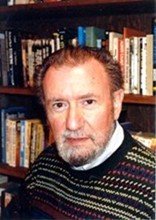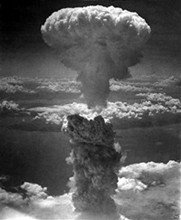“Paul Boyer, Fallout: A Historian Reflects on America’s Half-Century Encounter With Nuclear Weapons,” The Daily Cardinal, September 22, 1998
Paul Boyer had just celebrated his 10th birthday when on August 6, 1945 President Harry Truman announced that the Japanese city of Hiroshima had become the world’s first target of the newly developed atomic bomb. Boyer, Merle Curti Professor of History at the UW-Madison and a self-described “intermittent” activist, has since written several books on the subject. His latest, Fallout, is a collection of his essays, op-ed pieces, book reviews and other writings on the bomb and its lingering fallout since its surreptitious inception more than a half century ago.
The intervening years have seen pronounced ebbs and escalations in both the growth of nuclear stockpiles and the attention given to this durable issue. However, those two facets of the bomb’s history have not always correlated.
“The whole history of our nuclear encounter,” Boyer said in a recent interview, “has been one of peaks of intense awareness and then periods of neglect when it seems to become kind of a non-issue.”
In a lecture given outside the Madison Public Library in 1982, Boyer termed the period from 1963 to the late 1970s the “Big Sleep,” calling the abrupt evaporation of the issue during that period “astonishing.”
1963 would seem a strange year to launch such a period of dormancy: the nation — and the world — had only just eluded nuclear calamity of a sort never before and never since approached. The Cuban Missile Crisis, as it came to be known, brought the world’s two superpowers, the Soviet Union and the United States, to the brink of obliteration and brought anti-nuclear activists to a new threshold of intolerance for the imposing nuclear menace.
The Limited Nuclear Test Ban Treaty, signed in 1963, brought to an end the testing of weapons in above-the-ground settings. It also brought to an end the proliferation of anti-nuclear sentiment, even as the proliferation of weapons continued unimpeded.
“With that treaty and the succession of arms control talks and the succession of treaties that were promulgated in the years that followed,” Boyer said, “I think millions of Americans got the sense that, ‘Well, this issue is under control; the powers that be are now dealing with it.’ [But] it’s also important to remember that other things were happening in the world, such as the Vietnam war and Watergate, and so on, which surged to the center of public attention.”
By 1963 there was no shortage of Americans convinced of the utter depravity of nuclear weapons. Their numbers were sufficient to create a credible activist front which helped produce the sentiment for the test ban treaty.
Yet at the outset of the atomic age, Americans, from the highest levels of government on down, displayed what Boyer calls “bizarre extremes of reaction” and a “profound ambivalence” toward the new technology.
“On the one hand,” Boyer said, “the bomb was associated in the public mind with victory over Japan, with the end of this terribly costly war which had been going on since 1941 for America. And that connection was made very strongly — that the bomb won the war. On the other hand, what I found, and this is what surprised me, is how quickly fears of future atomic attacks surfaced — literally within hours of Truman’s announcement. Those fears and anxieties just surged to the surface very quickly and that combination of apprehension and an almost euphoric hope of the prospects of nuclear energy — what it might mean for the future — continued to be characteristic of our culture in the decades that followed.”
President Truman himself grappled with these same tensions.
“In private musings, Truman reveals very deep apprehension and uneasiness about what the scientists [had] unleashed on humankind. In contrast to that are his public pronouncements. In public, Truman never acknowledged any of these reservations and never expressed any doubts about his decision; and, in fact, as time went by, he became more and more fixed in his very rigid unwillingness to even address the possibility that his decision, this action that the United States government took in August 1945, had ramifications [and] had implications that were very sobering. This is, I think, a very interesting feature that tells us something about Truman’s personality, but also about the American need to justify this decision.”
The Truman administration offered the American public a firm, streamlined rationalization for the decision, a rationalization that was commonly accepted and scarcely challenged for 20 years.
“In the mid-'60s,” Boyer explained, “several historians from different directions began to suggest that the decision actually had more complex sources than Truman and [Secretary of War Harry] Stimson had suggested. They did not reject the argument that of major consideration in the decision was the immediate military situation. But they also pointed out that Japan was essentially a defeated nation [and that] peace feelers were being put out from Tokyo. It was a very volatile and complex situation. These 'revisionist’ historians suggested that considerations relating to the Soviet Union, relating to the postwar power balance that was clearly already shaping up by 1945, were [a] factor in the decision. And yet President Truman and defenders of his position avidly, vehemently rejected that as though it was almost a kind of treasonable or heretical challenge to American virtue in a fundamental way.”
Indeed, Truman clung to such a degree of staunchness, placing his decision, in Boyer’s words, “beyond the reach of criticism,” that by the '60s his behavior bordered, according to Boyer, on self-parody. “I think it’s significant that the so-called revisionist view of the atomic bomb decision coincided with the Vietnam War era,” Boyer added, “an era when government military actions were being radically criticized.”
A generation later, President Ronald Reagan’s “militarized rhetoric” signaled a resurrection of anti-nuclear activism that took the form of the nuclear freeze campaign of the early '80s. By decade’s end, however, these forces had retreated once again.
“With the end of the Cold War, the declining fears of global-thermal nuclear holocaust, the nuclear issues that did remain seemed to sink off the radar screen entirely,” Boyer says. “Nuclear threats, nuclear dangers still remain, but I think the question of the moment is, will we again see a kind of surge of activist attention such as occurred in the '60s and the early '80s?”
On that question the answer so far is discouraging, Boyer feels.
“What I’ve seen in the '90s is a kind of absorption of nuclear themes in the mass culture where it simply loses its political resonance and becomes a kind of gimmick. So we’ve had a series of movies in the '90s like True Lies [and] Broken Arrow, in which [nuclear themes have] become a quick metaphor for triggering fear and anxiety for the period that you’re watching the movie, and when you walk out of the movie it’s completely forgotten.”
© 1998
Stephen Andrew Miles

